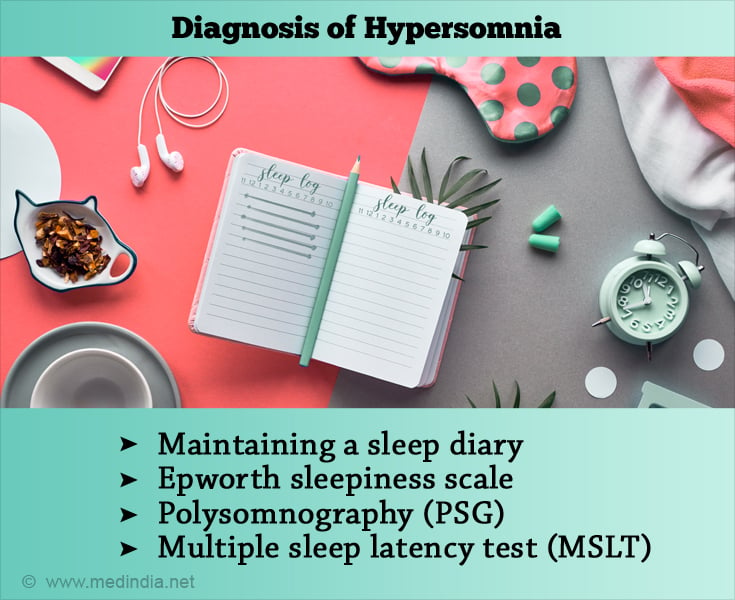Diagnosis
An accurate history, along with lab tests like Polysomnography and Multiple sleep latency test (MSLT), help in establishing the diagnosis of hypersomnia.
To establish the diagnosis of hypersomnia, an accurate history that describes the patient’s sleeping patterns, along with his past and present medical history, is essential. A diagnosis of recurrent primary hypersomnia is established when periods of excessive sleepiness lasts for at least 3 days and occur several times a year, for at least 2 years.

The diagnostic tools include:
A. Self-screening questionnaire for hypersomnia:
- Do you feel sleepy despite uninterrupted sleep for 10 hours every night?
- Are you experiencing excessive sleepiness for more than three months?
- Are short naps during the day not making a difference? Do you still feel tired and sleepy?
- Are you devoid of narcolepsy symptoms, such as cataplexy?
- Is your sleepiness NOT explainable by any of the following:
- Sleep disorders such as Obstructive Sleep Apnea, Restless Legs Syndrome, Periodic Limb Movement Disorder, or Narcolepsy
- Presence of mental or medical conditions.
- Substance abuse
If your answers to all of these questions are yes, then you might have idiopathic hypersomnia with long sleep time.
B. Maintaining a sleep diary gives better picture of a person’s sleeping patterns. A sleep diary is maintained for two weeks and a record is made of a person’s sleeping habits, which includes the time of going to sleep, the time of waking up and the time in between when he is awake.
C. Epworth sleepiness scale is a self-assessment tool which gives a standardized assessment of daytime sleepiness. This technique is very helpful in evaluating the depth of sleepiness in a hypersomniac.
D. The Polysomnography (PSG) is an overnight test that is done in a laboratory. Several measurements are taken continuously while a patient is asleep, to document abnormalities in the sleep cycle. It helps to exclude other sleep disorders like - Obstructive Sleep Apnea, Periodic Limb movement disorder, and Narcolepsy.
Findings that may be observed on a nocturnal Polysomnography study in the case of primary insomnia include:
- Short sleep latency
- Absence of arousals or awakenings
- Normal distribution of REM and NREM sleep
- Prolonged sleep duration.
In addition to these features in Kleine-Levin syndrome if the EEG study is performed during an episode of hypersomnia, an outburst of theta activity may be seen, which signifies drowsiness.
E.
The MSLT is conducted in a gap of two hours between 5 day time naps to gauge the presence of pathological sleepiness.
- Sleep latency test: It measures the amount of time it takes for a person to fall asleep. Sleep latency periods are normally 10 minutes or longer hence, a latency period of 5 minutes or less is suggestive of narcolepsy or hypersomnia. Mean MSLT score was found to be 6.5 ± 3.2 minutes for idiopathic hyper somnolence.
- Absence of sleep onset REM (SOREM): Rapid eye movement sleep during the first 15 minutes of sleep is called Sleep Onset REM (SOREM). Narcolepsy is excluded by the absence of sleep-onset REM periods on the 5-nap MSLT.
F. Laboratory studies Along with the above tests it is also advisable to receive a:
- Complete blood cell count,
- Screening biochemistry test,
- Thyroid-stimulating hormone test
These tests helps in excluding common physical disorders that may present with complaints of excessive tiredness, which is often expressed as excessive sleepiness by patients.
 MEDINDIA
MEDINDIA

 Email
Email









